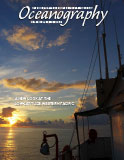Article Abstract
In the subtropical western North Pacific Ocean, the Kuroshio delivers heat, salt, and momentum poleward, much like its North Atlantic analog, the Gulf Stream. Though the Kuroshio generally flows along the western boundary from Taiwan to southeastern Japan as an “attached” current, the Kuroshio’s strength, vertical structure, and horizontal position undergo significant temporal and spatial variability along this entire route. Ubiquitous mesoscale eddies and complicated topography associated with a string of marginal seas combine to make the western North Pacific a region with complex circulation. Here, we synthesize results from the recent US Origins of the Kuroshio and Mindanao Currents and Taiwan Observations of Kuroshio Transport Variability observational programs with previous findings to build a comprehensive picture of the Kuroshio on its route from northeastern Taiwan to southeastern Japan, where the current finally transitions from a western boundary current into the Kuroshio Extension, a vigorously meandering free jet.

